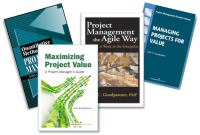There are endless posts predicting the demise of jobs that can be taken over by software agents: that information is not news go anyone I imagine.
Like this blog? You'll like my books also! Buy them at any online book retailer!

An opinion page on contemporary topics in project management

The essence of risk management lies in maximizing the areas where we have some control over the outcome while minimizing the areas where we have absolutely no control over the outcome and the linkage between effect and cause is hidden from us.
" ....... because as we know, there are known knowns; there are things we know we know. We also know there are known unknowns; that is to say we know there are some things we do not know. But there are also unknown unknowns—the ones we don't know we don't know."No luck
Present events are connected with preceding ones by a tie based upon the evident principle that a thing cannot occur without a cause that produces it. . . .Bernstein or Bayes' (with help from ChatGPT)
All events, even those which on account of their insignificance do not seem to follow the great laws of nature, are a result of it just as necessarily as the revolutions of the sun.


FBI Says People Are Using Deepfakes to Apply to Remote Jobs
So, what is Barr reporting that the FBI is saying?
According to the FBI’s announcement, more companies have been reporting people applying to jobs using video, images, or recordings that are manipulated to look and sound like somebody else.
These fakers are also using personal identifiable information from other people—stolen identities—to apply to jobs at IT, programming, database, and software firms.
The report noted that many of these open positions had access to sensitive customer or employee data, as well as financial and proprietary company info, implying the imposters could have a desire to steal sensitive information as well as a bent to cash a fraudulent paycheck.These applicants were apparently using voice spoofing techniques during online interviews where lip movement did not match what’s being said during video calls, according to the announcement. Apparently, the jig was up in some of these cases when the interviewee coughed or sneezed, which wasn’t picked up by the video spoofing software.
And, somewhat related insofar as fake references and supporting documention, the report includes this timely warning: "The FBI was among several federal agencies to recently warn companies of individuals working for the North Korean government applying to remote positions in IT or other tech jobs"
Bottom line: with remote interviews, some caution advised!
"Not learning to code just because there are AI coding agents is like not learning how to think because there are talk shows. Writing = thinking. Creating = imagining. Coding = building. If you're in tech in 2025 and you can't do these things, your career is at risk."Daniel Miessler

"I preferred to deal with chiefs of organisations rather than counsellors. Everyone should do a good day’s work and be accountable for some definite task.""It is easier to give directions than advice, and more agreeable to have the right to act, even in a limited sphere, than the privilege to talk at large"
Winston Churchill, WWII Memoirs
